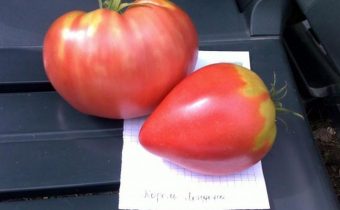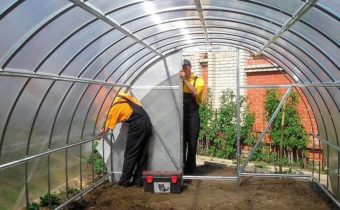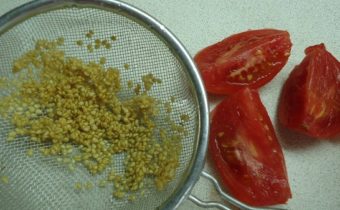Why do tomatoes grow sloppy and ugly?
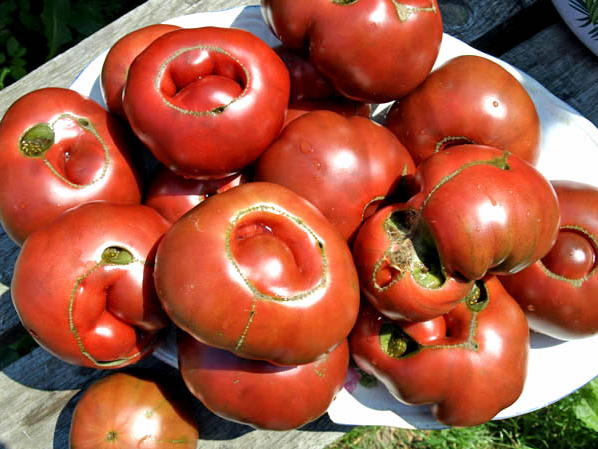
The irregular shape of the tomatoes is not only an aesthetic defect. The fused fruits, folds, protrusions and depressions significantly complicate the processing, do not allow making preparations for the winter, reduce the total useful mass of the crop. Therefore it is important to understand the causes of this phenomenon, to know the methods of struggle.
What it is and why it occurs
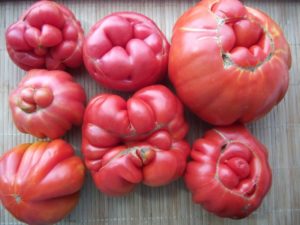
Deformation of the tomato fruit indicates that the plant has experienced a shortage of the substances it needs in one of the stages of the formation of the ovary. Such a crop to your taste, flavor is not inferior to even tomatoes, but the size of the fruit is often much larger, as well as its weight. The most common reason for changing shape is nutritional deficiencies. Tomatoes are very demanding to feed, so you should pay special attention to the number of introduced compounds:
- potassium;
- magnesium;
- nitrogen;
- phosphorus.
Despite the fact that the plant loves water, excessive moisture in conditions of poor air circulation is undesirable. The optimal amount of water - 1 liter for a bush per day. During the flowering period, the rate should be doubled, it will ensure rapid growth. To avoid bogging up the soil, rotting of the tomato and their deformation, it is necessary to observe the frequency of planting. The soil should be actively ventilated even in bad weather.
Heavy-growing bushes are planted with an interval of 50-65 centimeters, undersized with less lush foliage with an interval of 25-30 centimeters.
If the tomato is deformed in the lower part, it has hard bridges, and there is a noticeable discoloration on the skin, then the cause could be bacterial and fungal lesions of the bush. In this case, the ugly form is the lesser of problems. Inside, the pulp in the deformation zone will be tough and tasteless, perhaps even whitish. Such fruits are not stored, use them for blanks is undesirable, you can spoil the whole mass.
The “clumsy” shape can be the result of insufficient light and exposure to too low temperatures. When the fruits are already formed and have passed into the stage of maturation, such effects are not terrible for them. However, during the laying of ovaries, during the growth of tomatoes, weather conditions have the strongest effect.
One of the common causes of strain is a hereditary factor. Wrong independent seed collection contributes to the degeneration of varieties, increasing the percentage of irregular fruits. As a rule, a similar crop is typical for bushes obtained from the seeds of very large tomatoes, which are not characteristic of the initial variety.
First signs
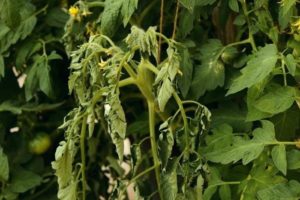
When the tomato is already deformed, the fruit has acquired its final irregular shape, this cannot be corrected, at the same time the plant's strength has already been spent on its growth and maturation. Therefore, it is important to notice signs of negative changes during the period of formation.
Ugly fruits grow mostly on accrete and too large flowers. The process of their growth is called fasciation. It is often accompanied by the bending of branches and shoots, the merging of individual stepchildren. The popular name for such an ovary is a royal or terry flower. He appears the very first. It must be cut off, especially if signs of fusion are visible.
Another “symptom” of deformation is deep grooves on the surface of a tomato. Even fruits have barely noticeable relief at the point of attachment to the branch.However, it is either impossible to feel with your fingers at all, or it is not pronounced vividly. For those fruits that later take on a clumsy and ugly shape, the furrows diverge over the entire area and penetrate deep into the flesh itself.
To prevent the emergence of such tomatoes, it is necessary to observe the bush itself. Anxiety symptoms are:
- pale leaf color;
- white bloom on the soil, stalks;
- appearance rot stains;
- wilting and yellowing of the lower leaves.
All of this suggests that tomatoes do not get enough nutrients or do take one of the most common diseases.
All these problems are relevant for growing in greenhouses. Very often, tomatoes suffer in greenhouses from high humidity and insufficient airing.
How to treat it
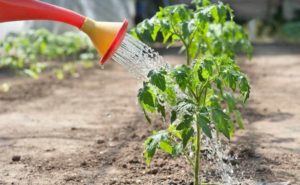
If the deformation is noticed against the background of other adverse changes, signs of disease are found, a simple treatment of the site should be performed. A solution of potassium permanganate in a concentration of 0.5 percent does not harm already grown tomatoes, but it can kill some common fungi and bacteria. If the cause of the deformation in excessive moisture, as well as a lack of fertilizer, will help feeding ash. You can make an infusion: one cup of dry matter in half a bucket of warm water, insist 2-3 hours, if necessary, slightly heated. Water the plant at the root. The same amount of ash can be applied to the soil in a dry form: sprinkle under a bush, burst, lightly pour.
If tomatoes have just started to form in the wrong form, you should urgently feed them. To do this, it is best to choose natural formulations without aggressive chemistry. During this period, all compounds will accumulate precisely in the fruit, which in consequence may adversely affect human health. Potassium and superphosphate can be used. In 10 liters of water dissolve a tablespoon of a mixture of these substances in equal quantities, water the plants at the rate of 2 liters per bush. A good effect is given by adding two teaspoons of Kemira to the dressing.
If the deformation is strongly pronounced, and the reason is established as insufficient nutritional value of the soil, a complex mixture of fertilizers can be made. For one bucket of water, take 20 grams of bird droppings or nutritional mullein, 25 grams of potassium sulfate, add 15 grams of saltpeter. All place, let stand for 4-6 hours, then watering in the usual amount.
Contrary to popular belief, the gray grid of hard strips on the “body” of the fetus has nothing to do with the process of pollination and the vital activity of bees as such. Therefore, the isolation of plants from insects will not be an effective method to combat this unpleasant phenomenon.
For the period of treatment it is necessary to choose the best watering mode. If the fruit is deformed and cracks at the same time, it is better to reduce the amount of water by half and water the plants only during the driest periods. Do the same if rot develops actively on the bush, a white patina appears on the ground. When the leaves are curled, wither, the fruit grows slowly, the weather is hot and dry, in this case it is better to increase the amount of water by one and a half times, replacing the flowing cold liquid with warm water.
Regular watering with extremely warm water will increase the yield, avoid the spread of many diseases and improve the taste of the fruits themselves. Such a measure is especially necessary in risky farming regions.
Prevention
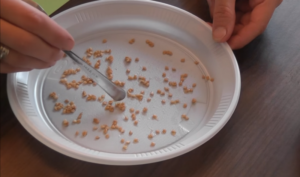
To correct the deformation of the tomato is very difficult after the fruit itself has formed. You can only prevent further deterioration of the situation, and cracking. The best effect can be obtained by conducting the proper prevention. The first of these measures include:
- Choosing the right variety for a particular region.
- Meeting deadlines.
- Careful selection seed material.
Planting only northern varieties in the northern regions is one of the main causes of the appearance of strange and ugly fruits. They simply do not have enough sunlight and heat. The same happens when trying to plant tomatoes early in the hope of favorable conditions. Do not take seeds from unfamiliar purchased vegetables, hybrid varieties. Selection of seed from fruits with excellent color and shape characteristics is one of the most important preventive measures.
Even during the formation of the ovary should carefully examine the flowers. All terry buds are cleaned on a mandatory basis. Sometimes there are not enough pollinating insects, in some cases too small pistils are formed. Such problems are particularly relevant for sites located near large cities, where there are basically few insects, as well as apiaries. Owners of greenhouses face these difficulties. In this case, you can help pollinate, spreading pollen through the pistils with a soft fluffy brush.
To the fruits were smooth, beautiful, it is necessary to conduct regular feeding. In the fall in the ground should be laid organic fertilizer. Before planting seeds, they should be awakened, pickled and filled with oxygen. Immediately after planting, fertilizing with stimulating agents is carried out, after nitrogen fertilizers.
Completely avoid the formation of "gnarled" tomatoes can not even professionals in industrial environments. However, to reduce their number, you can follow the simple rules of watering, feeding, choosing the right time and place for planting.



